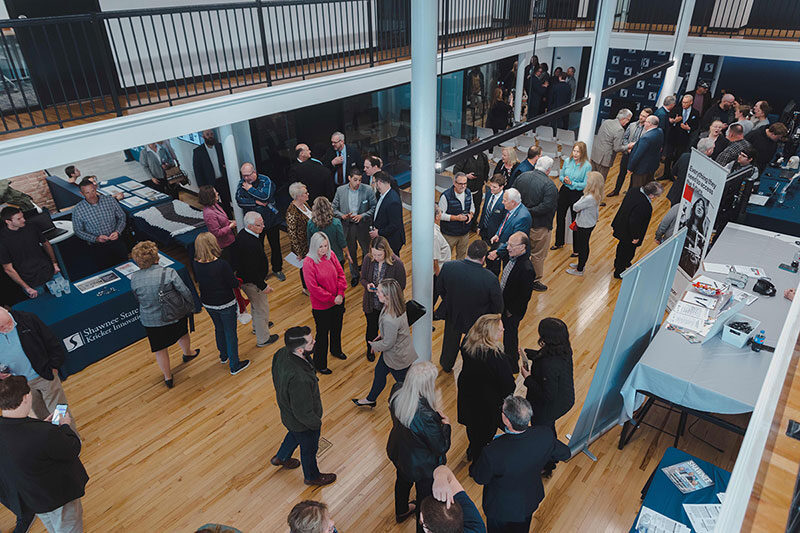Amanda Hedrick has her work cut out for her. As the Director of the Kricker Innovation Hub at Shawnee State University, she's been tasked with bringing a long-held vision to life: a coworking space that bridges the gap between the university and the broader community.
Since joining Shawnee State University in Portsmouth, Ohio in 2000, Hedrick has had many opportunities to bring projects to life. The Hub was just in its infancy when she arrived. Undeterred, she set to work, determined to transform the space into a thriving hub for innovation and entrepreneurship.
Hitting the ground running
"I came on board here in August 2023," Hedrick said. “I've been trying to piece together the history of the Hub and map out our future.” Part of that came in the form of a 2017 management plan that was developed pre-COVID. During the pandemic, of course, all initiatives were put on hold. But now that Hedrick has uncovered it, she has a roadmap.
 The management plan outlined the Kricker Innovation Hub's intended usage: coworking spaces, office units, makerspaces, meeting rooms, training rooms, computer labs, casual areas, phone booths, client storage space, kitchen, and coffee areas. Just to name a few.
The management plan outlined the Kricker Innovation Hub's intended usage: coworking spaces, office units, makerspaces, meeting rooms, training rooms, computer labs, casual areas, phone booths, client storage space, kitchen, and coffee areas. Just to name a few.
"It's been a lot of treasure-seeking," Hedrick admitted with a chuckle. "But I have been impressed with the foundation that was laid and the team that has been assembled to support this work."
With the plan unearthed, Hedrick set her sights on making it a reality. "We sat down and looked at our current grant awards and the metrics we had to meet for those grants," she explained. "Achieving those metrics has guided our work."
But Hedrick knew that meeting grant requirements was just the first step. To truly build the tech ecosystem they aimed for, they needed to offer everything outlined in the 2017 plan.
The Hub becomes a community anchor
One of the key elements of the Hub's mission is to serve as a touchpoint for the broader community, particularly the Arts, Cultural, and Innovation District right outside its doors.
"We are part of that ecosystem and one of the main anchors of the district," Hedrick said. "We meet regularly with other key stakeholders. They come in weekly or bi-weekly. We discuss common goals and priorities, like placemaking for our tech community and infusing opportunities for our broader population."
The Hub's influence extends beyond the tech sector, too. "We recently kicked off our Ignite Bootcamp, and most participants are artists looking to build businesses around their passion," Hedrick shared. "The arts community is a strong force for local entrepreneurship."

Extending the campus beyond boundaries
While the Hub serves as a community anchor, it also maintains close ties to the University as a whole, acting as a bridge between the campus and the surrounding area.
"Many community members benefit from our services and can also utilize university resources," Hedrick explained. "For example, we provide internships by connecting students with local businesses and nonprofits."
She cited the Hub's Main Street Portsmouth initiative as an example, which involves students in projects like mural restoration and marketing. Plus even larger initiatives. "Our MBA students are currently developing business plans for the new municipal stadium and how it can be activated to serve and drive revenue — demonstrating another connection between the campus and the community," Hedrick added.
Breaking down silos while constructing a community
At the heart of the Hub's mission is a desire to break down the silos that often divide communities, fostering a sense of shared purpose and ownership.
"Everyone is invested in this community," Hedrick said. "There's a lot of energy and momentum for the work we're doing. People want to be involved and see the transformation happening. We're not just a small town defined by the opioid crisis of the past decades; we're moving into a new era. The work we're doing now will be our legacy."
Hedrick sees the Hub's coworking space as playing a vital role in combating the growing loneliness epidemic and fostering civic engagement, much like organizations such as the Kiwanis did in years past — groups that now make use of the space at the Hub.
"Initially, building our coworking community was slow to grow because we had so many things to set up," she admitted. "We needed software, phone booths, Wi-Fi, and access systems. The makerspace didn't exist — but it does now, with audio recording studios, photography studios, 3D printers, CNC machines, and more. We wanted everything in place before promoting it heavily. Now, we're refining our processes and systems as we go."
For now, Hedrick wears many hats, including that of the community manager. "That's me right now," she said. "We aim for sustainability and hope to hire a dedicated staff member in the future."
As the Kricker Innovation Hub continues to grow and evolve, it's clear that it's more than just a coworking space — it's a central place for community building, innovation, and collaboration. With Hedrick at the helm, the Hub is poised to help shape the future of Shawnee State University and the surrounding community for years to come.